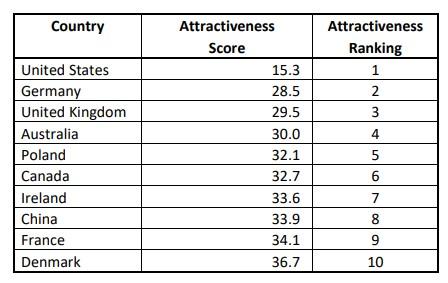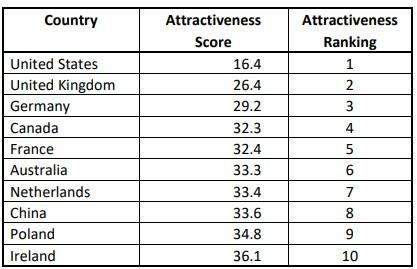Researchers at the Rosenberg International Franchise Center (RIFC) developed an index that ranks 131 countries according to their attractiveness as international franchise expansion markets for US-based franchises. This index is generated through a quantitative model that is based on peer-reviewed research and a survey of franchise executives. The model produces two different index rankings (Balanced Growth and Aggressive Growth) based on a company's risk tolerance levels.
Using a macro framework, the model incorporates key determinants of international market potential (market size, market growth, and purchasing power); and market risks (economic, political, legal, and regulatory risks) as well as geographic and cultural distances.
Many of these variables are not directly observable. Therefore, the use of proxies is necessary in order to operationalize them.
Population GDP Per Capita & GDP Growth
A country’s market potential is proxied by the weighted average of its population size (representing the number of potential customers), its real GDP growth over the most recent five years (to capture market growth), and its per capita GDP (representing its nations’ purchasing power).
The above three measures are obtained from the International Monetary Fund’s World Economic Outlook.
Economic & Political Risks
Economic and political risks are proxied by the Euromoney’s Country Risk Index, an index that is widely used to capture a country’s economic and political risks.
Legal & Regulatory RIsks
Legal and regulatory risks are proxied by the World Bank’s Ease of Doing Business Index, an index that captures the key factors that determine the legal and regulatory risks that may face a company operating a business in a foreign country.
Geographic & Cultural Distance
- Geographic distance is computed by taking the simple average of the target country ranking in terms of distance in miles from the franchisor host country and its ranking in terms of travel time to reach it from the host country.
- Cultural distance is quantified by computing an index based on the differences in Hofstede’s four cultural dimensions: uncertainty avoidance, individualism, masculinity, and power distance.
A survey of more than 100 franchise executives representing franchise companies with more than 165,000 units globally helped provide the relative weights of the different determinants of franchise internationalization decisions.
Methodology
Following standard indexing methodology, country attractiveness scores are produced by computing the weighted average of all components:
Attractiveness scores are computed for 131 countries that had populations of at least one million people, and that had publicly available data. These scores are then ordered from lowest (#1 being most attractive) to highest (#131 being least attractive) to obtain the country attractiveness index.
Two sets of Indices are generated:
- Balanced Growth: Relevant for companies that are seeking international franchise expansion opportunities with balanced potential risks and returns.
- Aggressive Growth: Relevant for companies that are willing to take significant risks in order to capitalize on large opportunities in international markets.
The methodology is described in detail in several peer-reviewed academic research papers, including:
- Aliouche E.H. (2017) “International Franchising: Optimal Market Selection” in Terry A., Hoy F. and Perrigot R. (editors), The Edward Elgar Handbook on Franchising
- Aliouche E.H., (2015). “The Impact of the Global Financial Crisis on Country Attractiveness.” Thunderbird International Business Review. 57(1), 63-83.
- Aliouche E.H., Schlentrich U., Frazer L. (2012). “Internationalization Modeling: A Comparative Analysis of American and Australian Franchise Firms.”Journal of Marketing Channels, 19:77-97
- Aliouche E.H., Schlentrich U. (2011). “Towards a Strategic Model of Global Franchise Expansion.” Journal of Retailing, 87 (3, 2011), 345-365
- Aliouche E.H., Schlentrich U. (2011). “A Model of Optimal International Market Expansion: The Case of US Hotel Chains Expansion into China.” In Contributions to Management Science: New Developments in the Theory of Networks: Franchising, Alliances and Cooperatives, pp. 135-154, Springer Verlag (Germany)
2023 International Franchise Attractiveness Index Country Ranking

Balanced Growth Model
2022 International Franchise Attractiveness Index Country Ranking

Balanced Growth Model





